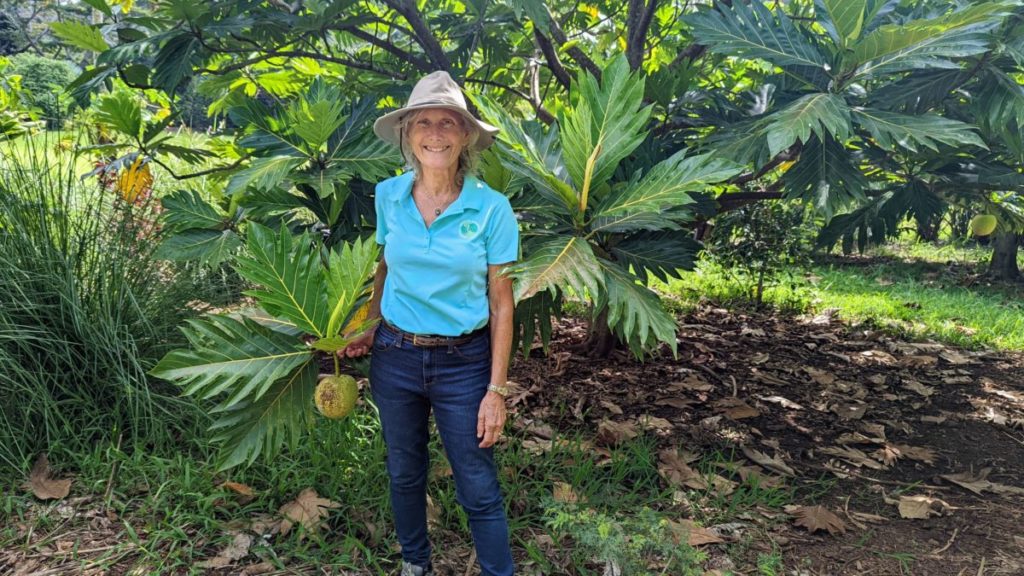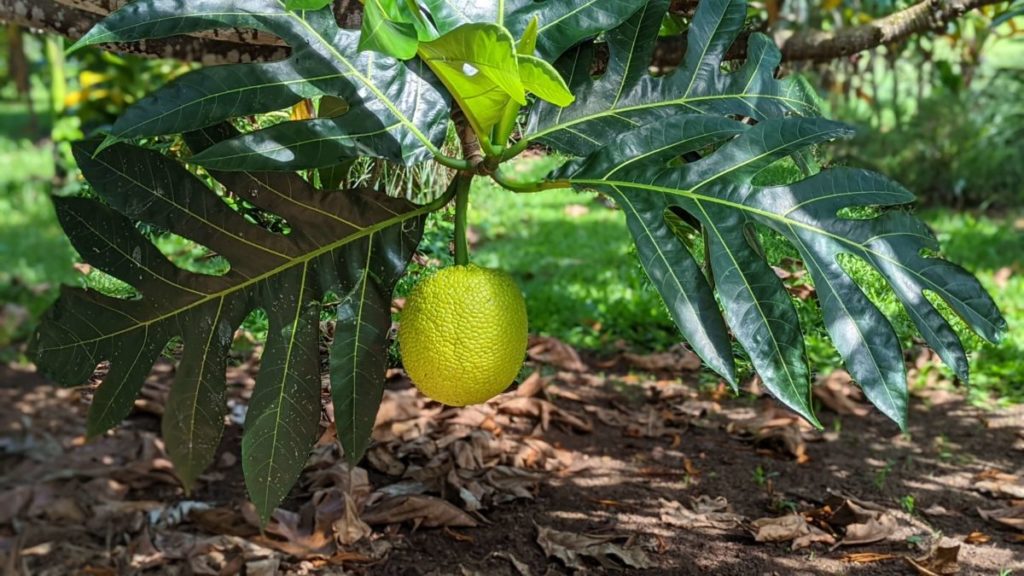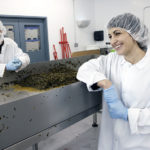
Editor’s Note: We’re keenly interested in women combatting climate change. Apply now for our Women In Science Incentive Prize.
Dr. Diane Ragone’s piercing blue eyes sparkle when she talks about breadfruit. The 69-year-old has devoted her entire working life to studying the strangely shaped, voluptuous produce that tastes more vegetable than it does fruit.
Starchy, carby and sweet if left on the branch long enough, Ragone will eat it every which way. “I will never get bored of it,” she says, over a mouthful of breadfruit “nachos” that she’s prepared at her house on Kauai, Hawaii. “Never.”
Breadfruit grows throughout the Pacific, Caribbean, Central America and Africa. It is around the size of a melon, with a spiky or pebbled skin that can range in color from brown to green-yellow. The name derives from white voyagers, who when first servedroasted breadfruit declared it smelled like baked bread. A small serving of the fruit provides ample fiber, protein, magnesium, potassium – and many more vital minerals.
In a world threatened by climate change and walloped by global pandemics and war, breadfruit is increasingly seen as a stable crop that can help combat global hunger. Recent research shows that breadfruit is climate-resilient, meaning that it can still thrive in hotter conditions even as other crops – rice, corn and soybeans – struggle and decrease in yields.
“Breadfruit is a neglected and underutilized species that happens to be relatively resilient in our climate change projections,” said Daniel Horton, a climate change scientist at Northwestern University. Horton co-authored a 2022 study about the potentials of breadfruit in food insecure regions. “As we implement strategies to adapt to climate change, breadfruit should be considered in food security adaptation strategies.”
In some cultures, there is a tradition to plant a breadfruit tree when a child is born. “This is to ensure the child will have food for the rest of their life,” explains Nyree Zerega, a conservation scientist with the Negaunee Institute for Plant Conservation Science and Action at the Chicago Botanic Garden. “Breadfruit trees can live for decades and provide a large amount of fruits each year.”

Although there are now multiple organizations researching the value of breadfruit, and many breadfruit initiatives being rolled out across the Caribbean, this was certainly not the case when Ragone began her breadfruit journey in the early 1980s.
Ragone is the director emeritus of the Breadfruit Institute of the National Tropical Botanical Garden, based in Hawaii, and for the past three and a half decades has been studying, analyzing, growing and preaching breadfruit.
Almost single-handedly, Ragone has brought this superfood to the world’s attention.
“I realized that this important tree in the Pacific Islands – the primary staple crop on many islands and a multipurpose tree with many uses to people and the environment – was at risk and the diversity of varieties needed to be studied and documented, and more importantly conserved,” she explains. “It was important to bring it to the world’s attention.”
She has traveled the Pacific region collecting as many breadfruit varieties as possible and has feasted on breadfruit in many ways, including eating fruit that had been buried underground for years as part of a local ritual.
For years, it was trial and error as to how to propagate the trees back at the institute. Initially, Ragone gathered the seeds, which wouldn’t grow. But over time, she realized that it was in fact the roots that needed gathering – the seeds lose their ability to grow if they are stored, chilled or dried.
Back at the National Tropical Botanical Garden, Ragone and her team propagate the cuttings and grow them on the lush land that surrounds the institute’s headquarters. They currently have a grove of 150 breadfruit varieties, and have begun shipping saplings to nonprofits and communities across the world to enable them to grow their own breadfruit resources.
One such successful program began in 2008, when a benefit-sharing arrangement was put in place with the Samoan government to distribute the Ma’afala variety that an NTBG botanist had collected from Samoa in the 1970s and conserved in the institute’s living collection. Now, the government receives half of all revenues generated by NTBG from selling the variety to horticultural companies. “We wanted to set a standard for benefit-sharing for plant genetic resources,” Ragone says.
Since then, the institute and numerous collaborators have shipped 150,000 saplings to 46 tropical countries – places where rates of hunger and poverty are highest. Farmers in countries like Costa Rica, Haiti and Nigeria are already growing some of the varieties developed by Ragone’s team.
The institute is also training small scale farmers in agroforestry, or moving away from monocultures and planting native produce crops, like the breadfruit.
It’s a hard task, though, as farmers’ profit margins are often so slim that it’s near-impossible to take risks. A lot of Ragone and her team’s work is around outreach and education – a slow, long-term process that is gradually persuading farmers to diversify their crops.
The global population is expected to increase by 2 billion people in the next 30 years, according to the United Nations, which means food production will have to increase by more than 60%. The UN’s Food and Agriculture Organization has noted that agroforestry is “part of the solution” to addressing land management and food production issues.
Breadfruit trees offer several advantages over other staples, according to Ragone. They’re fast-growing, and require far less labor, fertilizer and pesticides than rice and wheat crops.
“I feel this is just a start,” says Ragone, who has 40 years of information about breadfruit in the form of field journals, plant logs, photographs and video interviews with Pacific islanders. She would like to see more trees of more varieties distributed, and a continued focus on documenting the biocultural knowledge of the Pacific and Caribbean islands.
But so far, the impact that breadfruit has had around the world is “an amazing accomplishment that took years of hard work by many people,” she says.
The work has left Ragone feeling “proud and happy and challenged.”
“It’s an amazing accomplishment that took years of hard work by many people.” ◼


